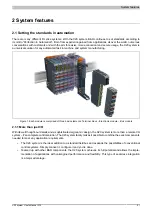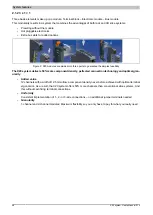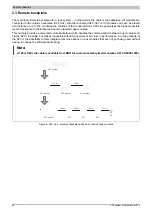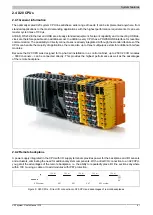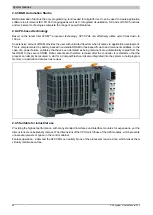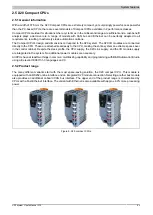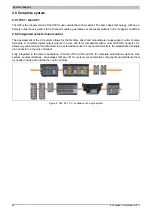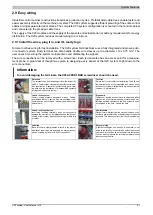
System features
X20 system User's Manual 3.10
71
2.12 Embedded parameter chip
Information such as module type, serial number, functionality and version number is contained in the embedded
parameter chip of the X20 module. This information is automatically evaluated by the programming environment
(Automation Studio) and by the application program. This prevents errors during both commissioning and service.
In addition, the system configuration is automated and flexible variations are made possible.
Serial numbers of modules that are defined worldwide are gaining increasing significance in validated systems as
demanded, for example, by the FDA.
2.13 Space for options
The X20 system family makes it possible to combine the exact components necessary depending on the user's de-
mands and individual application requirements. This allows machine options to be implemented easily and flexibly.
Bus modules provide the base, and are more or less a rack replacement. Depending on the option, the necessary
electronics modules are then inserted in the predefined slots.
Addresses are assigned implicitly via the slot. Software that has been developed once is valid for all versions and
does not need to be changed. This is even possible for later machine expansion. The I/O modules are simply
inserted in the defined bus modules, and assigned to the corresponding potential groups and E-stop groups.
To prevent unwanted expansion, each module can be identified and then enabled using the application software.
2.14 Flexibility for options
The implementation of different machine variations using free bus modules is only one of the many features that the
X20 system offers. With the support of B&R Automation Studio, there is an optimized solution using I/O mapping.
What does this mean?
Each I/O configuration is created optimally according to the actual requirements. However, the application software
is designed to handle all potential options. Only the I/O channels that are actually available are configured in the
application program. If an expansion is required, then the additional hardware needed can be easily connected
and the I/O mapping changed. This is done without having to compile the application software.
It doesn't matter where the I/O mapping list is created:
•
Manually in B&R Automation Studio
•
With tools, e.g. with a database or a table calculation program
•
Directly from an ERP system, just like the parts list for the machine
•
Automatically in the application software, depending on the hardware used
Machine variation A
The possibilities of the X20 system can be best explained using examples. This is a ma-
chine constellation with two variations, A and B. All of the necessary electronics modules
for machine variation A are shown in the picture to the left. The bus modules needed for
variation B are also present, but without electronic modules.
Machine variation B
Variation B shows the necessary electronic modules but the modules necessary for vari-
ation A are missing. The distribution of the free bus modules for the variations is also
clear: The variable I/O modules can be very easily connected to the required electrically
isolated groups and don't need to be attached in the back. The extensive process of
taking apart the configuration to expand existing electrically isolated groups is also elim-
inated. Simply insert the electronic module and attach the terminal block.
Machine variation A - optimized
The features included in Automation Studio can also be used to achieve completely opti-
mized hardware configurations without losing the advantage of comprehensive applica-
tion software for all variations. As described earlier, simply mapping physical I/O points
to the application program makes it extremely easy to optimize the hardware variations
without even requiring compilation.

